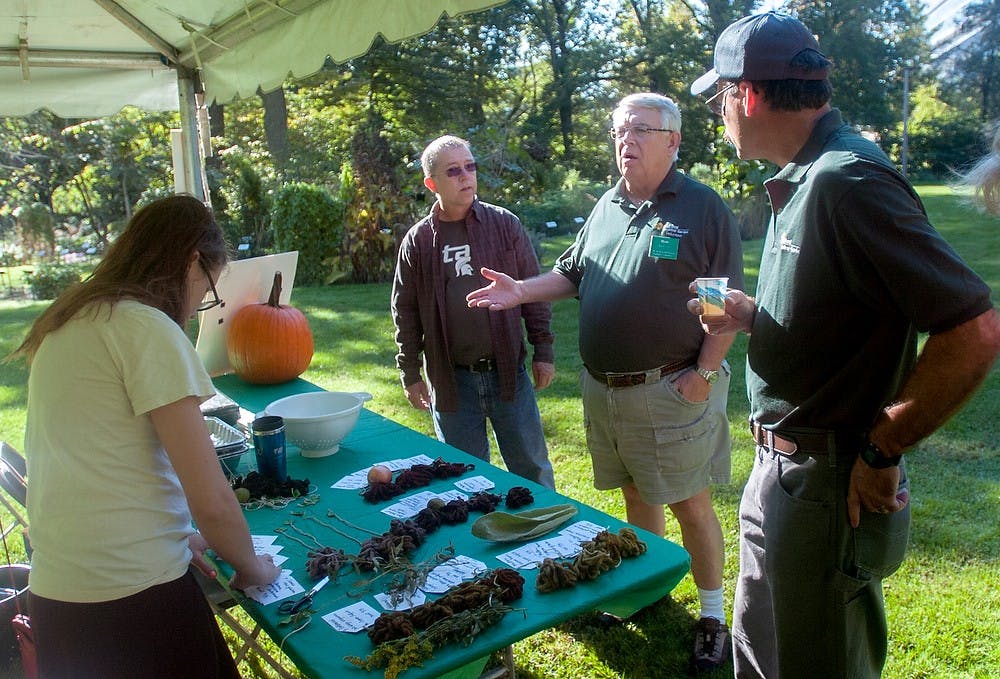“Keep squinting.”
This was the motto of the late professor William Beal, who created the W. J. Beal Botanical Garden in 1873 as a way to get his students out of the lecture hall and into the natural world.

Lansing resident Dave Veale, left, volunteer coordinator Ron Overton, center, and botanical technician Pete Murray, right, gather around to look at the naturally dyed strings. The event included cider and doughnuts, a pumpkin giveaway and presentations about the history of Beal Garden. Brian Palmer/ The State News
“Keep squinting.”
This was the motto of the late professor William Beal, who created the W. J. Beal Botanical Garden in 1873 as a way to get his students out of the lecture hall and into the natural world.
“To him, the garden was a living laboratory,” garden curator and plant biology professor Frank Telewski said. “He wanted his students to be keen observers of their environment. He’d say, ‘Tell me what you see,’ over and over, and as the students gave answers, he kept pushing them. He just told them to keep squinting.”
The Beal Botanical Garden turned 140 this year, and the garden’s history was honored Saturday with a small anniversary celebration featuring guided tours and cider and doughnuts.
Telewski discussed Beal’s many accomplishments — hybridizing corn and planting trees throughout campus and the rest of the state as well as advising farmers about deforestation and weeds.
In 1876, Beal corresponded with evolutionary scientist Charles Darwin, expressing a desire to hybridize corn. Darwin wrote back that he was “glad you intend to experiment” in a letter that Beal cherished and hung in his office.
He was then inspired to cross genetic lines of corn, and his original experiment led to the hybrid corn people eat today, rich in kernels and produced in large yields, Telewski said.
Beal began an experiment in 1879 that has been passed down among garden curators throughout the years — trying to find out how long seeds remain viable in soil. Beal planted different species of seeds in glass bottles filled with sand and buried them on campus, excavating them over time to see which seeds germinated, Telewski explained.
Telewski excavated the bottles in 2000 and found two species germinating — one of these, the moth mullein, is the flowering plant used as the garden’s symbol.
Landscape architecture junior Emily Prieskorn has been working in the garden since her freshman year and said taking care of the garden has been incredibly rewarding.
“It brings joy to people and it connects them to the natural world,” Prieskorn said. “Plants offer so much. It creates a people-plant connection.”
The historic garden is a modern-day classroom for MSU students in a variety of majors, and it’s also part of a global network with the International Seed Exchange Program, Telewski said.
“Global institutions can order seeds from each other and teach each other,” Telewski said. “It’s a great way to maintain biodiversity.”
Students of any academic background are encouraged to apply for a job or volunteer in the Beal Garden, according to Pete Murray, who supervises Beal’s student employees.
“We’re lucky in the sense that students come through this beautiful area and ask if and how they can work. We fill our needs quickly,” Murray said. “And Beal picked a spot that can never be developed by the university — it’s a little hidden secret on a flood plane next to the Red Cedar. He was a visionary.”
Support student media! Please consider donating to The State News and help fund the future of journalism.